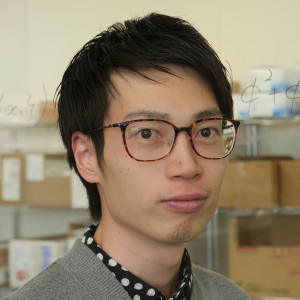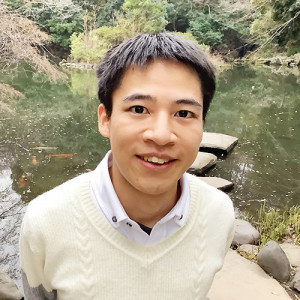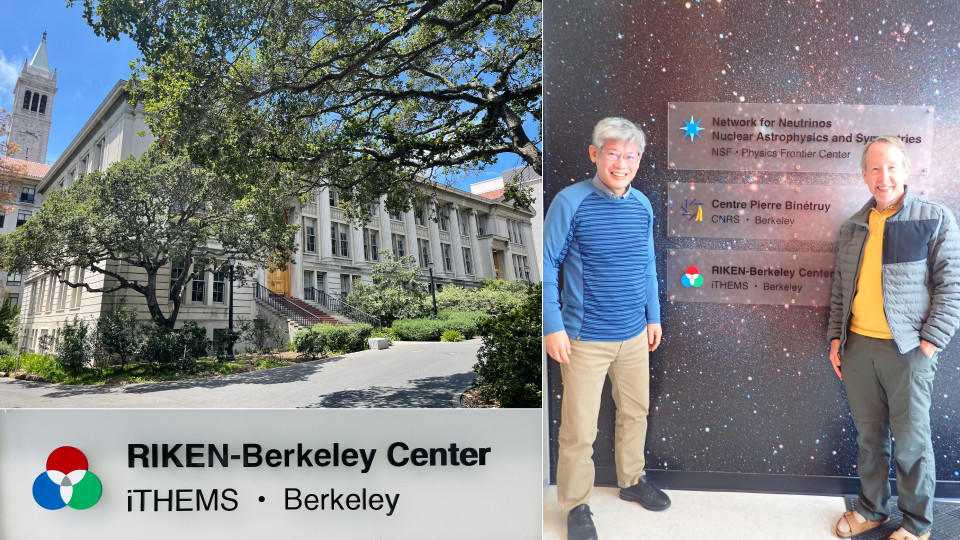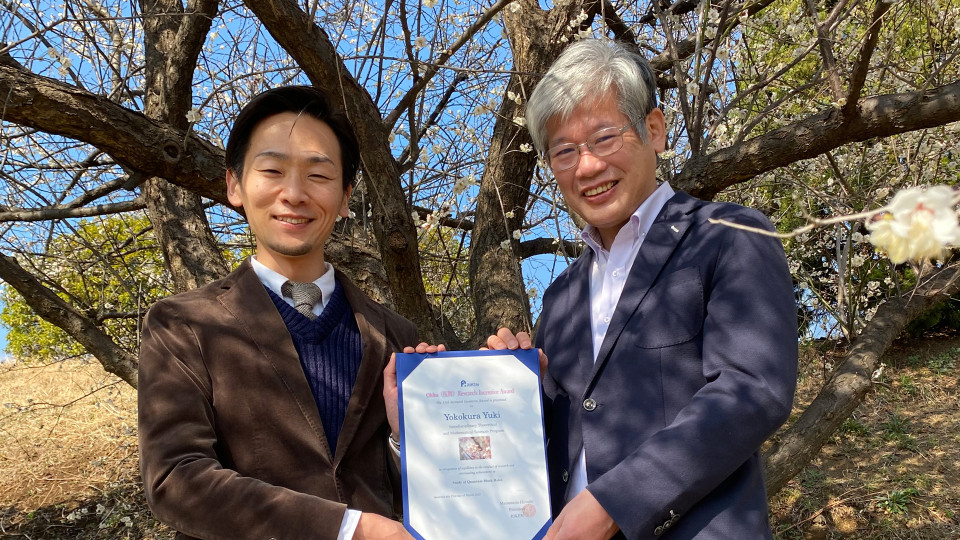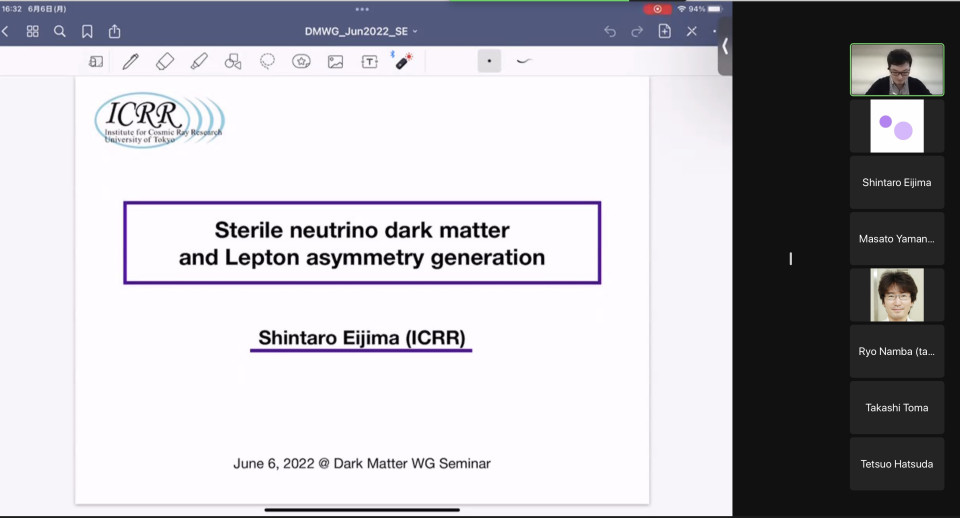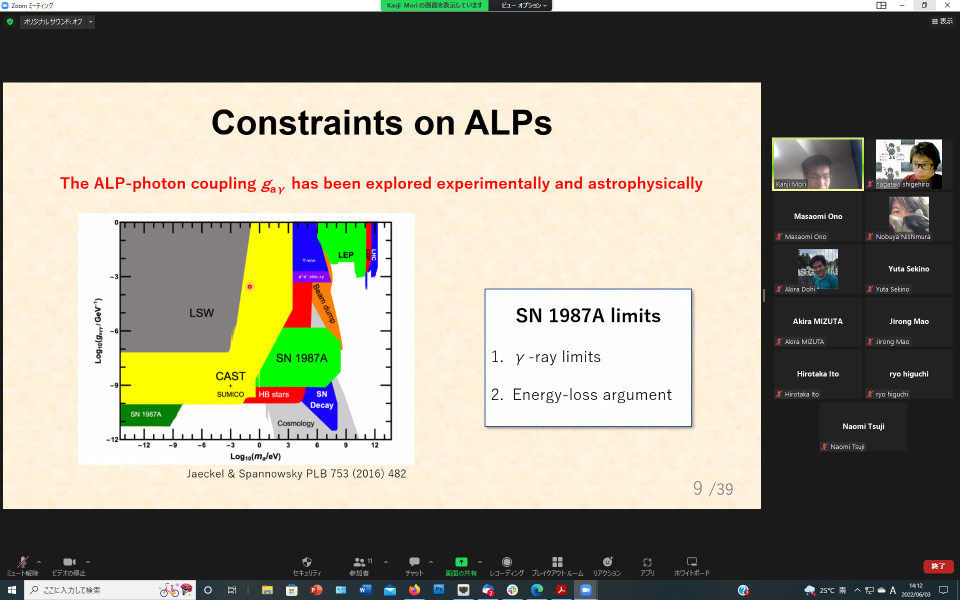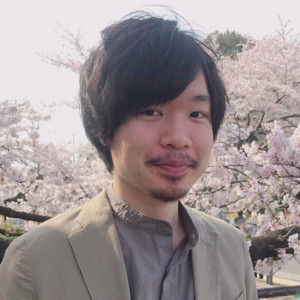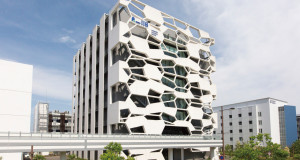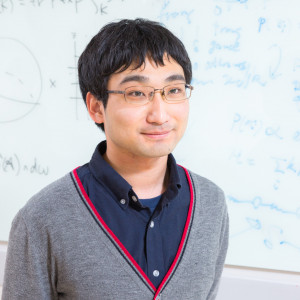Volume 202
Back to Newsletter List
Press Release
Common Laws of Evolution and Ecological Dynamics
2022-06-06
The research team of Kyosuke Adachi (Special Postdoctoral Researcher, iTHEMS / Special Postdoctoral Researcher, Nonequilibrium Physics of Living Matter RIKEN Hakubi Research Team, RIKEN Center for Biosystems Dynamics Research (BDR)), Ryosuke Iritani (Research Scientist, iTHEMS) and Ryusuke Hamazaki (Senior Research Scientist, iTHEMS / RIKEN Hakubi Team Leader, Nonequilibrium Quantum Statistical Mechanics RIKEN Hakubi Research Team, RIKEN Cluster for Pioneering Research (CPR)) have proposed a broadly valid formula for theoretical models of evolutionary and ecological population dynamics using methods from information theory and statistical physics.
The results of this research are expected to lead to a unified framework for understanding complex population dynamics in evolutionary and ecological systems over time.
For more information, please see the related link.
Reference
- Kyosuke Adachi, Ryosuke Iritani and Ryusuke Hamazaki, Universal constraint on nonlinear population dynamics, Communications Physics 5, 129 (2022), doi: 10.1038/s42005-022-00912-4
Hot Topic
RIKEN-Berkeley Center was opened
2022-06-09
RIKEN iTHEMS and N3AS Physics Frontier Center have started a joint research center, RIKEN-Berkeley Center (RBC), physically located on the 3rd floor of the physics building in Univ. California, Berkeley. This new Center aims to enhance the collaboration on nuclear astrophysics and quantum information science between the two institutions. On May 27-29, 2022, the first annual meeting of N3AS was held in Berkeley together with their international partners, RIKEN iTHEMS and CNRS Centre Pierre Binetruy. iTHEMS members are encouraged to use RBC as a base to interact with researchers in physics, mathematics, biology and related fields at Berkeley.
Hot Topic
Ryosuke Iritani was interviewed by The Big Issue of Japan
2022-06-06
Ryosuke Iritani (Research Scientist, iTHEMS) is interviewed by The Big Issue Japan, and the latest volume (vol 432) is just published on 1st June.
The Big Issue is a magazine dedicated to supporting people in difficult circumstances and helping them achieve self-reliance. Each issue costs 450 yen, out of which 230 yen is the direct income of the street sales staff.
The content is about mathematical biology and is accessible for anyone. We hope as many people as possible take it a read and support the people!
Award
Dr. Yuki Yokokura received The 13th RIKEN Research Incentive Award (Ohbu Award)
2022-06-08
Yuki Yokokura (Senior Research Scientist, iTHEMS) received "The 13th RIKEN Research Incentive Award (Ohbu Award)" on March 23, 2022 for his outstanding achievement in the "Study of Quantum Black Holes". Congratulations!
Seminar Report
DMWG Seminar by Dr. Shintaro Eijima on June 6, 2022
2022-06-08
Dark matter (DM) is one important ingredient of our Universe of which existence indicates the theory beyond the Standard Model. It is not the unique motivation to extend the Standard Model describing the visible world. For example, we need to explain the origin of the tiny neutrino mass and the matter-antimatter asymmetry. The introduction of sterile neutrinos could solve these problems simultaneously.
Sterile neutrinos are new species of neutrinos which communicate with the Standard Model neutrino (active neutrinos) through mixing. Unfortunately, the possibility of explaining the whole of DM with the sterile neutrinos is already excluded from observations of X-ray emission, neutrino beam experiments, and cosmological requirements. However, it is still a viable candidate when we consider the production mechanism carefully. Furthermore, some of such scenarios expect large lepton asymmetries resulting in the matter-antimatter asymmetry. The sphaleron process takes an important role in such scenarios and it is related to the electroweak phase transition in the early Universe. The process of fixing the lepton asymmetry is interesting: sterile neutrinos first freeze-in, then freeze-out, and decay.
Quantitative prediction of such processes requires sophisticated calculations. Dr. Eijima has shown the latest results in this talk, with the comments that the bottleneck to proceed is the computational costs. The methodology is already well-developed. We will see indicative predictions in the near future! Neutrino physics will open new windows for our Universe!
Reported by Nagisa Hiroshima
Cosmological phenomena with sterile neutrino
June 6 (Mon) 16:30 - 18:00, 2022
Seminar Report
ABBL-iTHEMS Joint Astro Seminar by Dr. Kanji Mori on June 3, 2022
2022-06-08
Axion-like particles (ALPs) are a class of hypothetical bosons that feebly interact with ordinary matter. The hot plasma of stars and core-collapse supernovae is a possible laboratory to explore physics beyond the standard model, including ALPs. Once produced in a supernova, some of the ALPs can be absorbed by the supernova matter and affect energy transfer. The speaker recently consistently calculated the ALP emission in core-collapse supernovae and the backreaction on supernova dynamics. It is found that the stalled bounce shock can be revived if the coupling between ALPs and photons is as high as $g_{a\gamma}\sim 10^{-9}$ GeV$^{-1}$ and the ALP mass is 40-400 MeV.
Reported by Shigehiro Nagataki
Core-collapse Supernova Models with Heavy Axion-like Particles
June 3 (Fri) 14:00 - 15:00, 2022
Upcoming Events
Seminar
iTHEMS Math Seminar
Algebraic geometry in mixed characteristic
June 10 (Fri) 14:00 - 16:30, 2022
Shou Yoshikawa (Special Postdoctoral Researcher, RIKEN Interdisciplinary Theoretical and Mathematical Sciences Program (iTHEMS))
In algebraic geometry, we study the geometry of algebraic varieties, which are sets defined by algebraic equations.
There are two types of algebraic varieties, they are varieties over characteristic zero and varieties over positive characteristic.
Algebraic geometry in characteristic zero is similar to analytic geometry, so it is related to many other subjects.
In this talk, I will introduce the notion of algebraic geometry in positive characteristic and relationships between positive characteristic and characteristic zero.
In order to study it, we consider families consisting of varieties over characteristic zero and varieties over positive characteristic, called mixed characteristic.
Venue: Hybrid Format (Common Room 246-248 and Zoom)
Event Official Language: English
Seminar
Quantum Matter Seminar
Introduction to Topological Insulators: The Ten-fold Classification of Topological Insulators and Superconductors Part.2
June 13 (Mon) 14:00 - 15:30, 2022
Ching-Kai Chiu (Senior Research Scientist, RIKEN Interdisciplinary Theoretical and Mathematical Sciences Program (iTHEMS))
References
- Andreas P. Schnyder, Shinsei Ryu, Akira Furusaki, and Andreas W. W. Ludwig, Classification of topological insulators and superconductors in three spatial dimensions, Phys. Rev. B 78, 195125 (2008), doi: 10.1103/PhysRevB.78.195125
- Alexei Kitaev, Periodic table for topological insulators and superconductors, AIP Conference Proceedings 1134, 22 (2009), doi: 10.1063/1.3149495
Venue: via Zoom
Event Official Language: English
Seminar
NEW WG Seminar
Non-Abelian vortices in two-flavor dense QCD
June 15 (Wed) 13:30 - 15:00, 2022
Yuki Fujimoto (Postdoctoral Scholars, Department of Physics, University of Washington, USA)
Recently, the phase of the two-flavor quark matter with the new
pattern of color superconductivity was proposed so that the continuous
crossover from the hadronic to the quark phase is realized [1]; it is
in consonance with the recent observation of neutron stars.
In this talk, I will show the classification of the topological
vortices in this phase. We found that the stable vortices are what we
call the "non-Abelian Alice strings" [2]. They are superfluid
vortices carrying 1/3 quantized circulation and color magnetic fluxes.
I will discuss their properties in comparison to the well-established
CFL vortices in three-flavor symmetric setup, by putting some emphasis
on their peculiarity: the non-Abelian generalization of the Alice
property. I will then discuss in detail the possibility that these
vortices are confined as well as how the vortices in the quark phase
can be connected to those in the hadronic phase [3].
[1] Y. Fujimoto, K. Fukushima, W. Weise, PRD 101, 094009 (2020) [1908.09360].
[2] Y. Fujimoto, M. Nitta, PRD 103, 054002 (2021) [2011.09947]; JHEP 09 (2021) 192 [2103.15185].
[3] Y. Fujimoto, M. Nitta, PRD 103, 114003 (2021) [2102.12928].
Venue: via Zoom
Event Official Language: English
Seminar
Math-Phys Seminar
Implications of singularity theorem for non-singular universe
June 16 (Thu) 13:30 - 15:00, 2022
Daisuke Yoshida (Designated Assistant Professor, Graduate School of Mathematics, Nagoya University)
The singularity theorem by Penrose shows that a spacetime singularity arises in certain universal situations. The existence of a spacetime singularity is thought to represent a breakdown in the validity of theories such as general relativity and the phenomenological models of the universe. Thus, if we could build a correct model that describes the beginning of the universe, the universe predicted by that model should be non-singular. In this talk, we will discuss general properties that a non-singular universe must satisfy in order to avoid the singularity theorem. In particular, we will see that the universe must be, in some sense, smaller than the corresponding closed de Sitter spacetime.
Venue: Hybrid Format (Common Room 246-248 and Zoom)
Event Official Language: English
Seminar
iTHEMS Biology Seminar
Self-organisation of a dynamic meshwork structure in the mesoderm during the development of a chick embryo and its characterisation using persistent homology
June 16 (Thu) 16:00 - 17:00, 2022
Mitsusuke Tarama (Research Scientist, Laboratory for Physical Biology, RIKEN Center for Biosystems Dynamics Research (BDR))
Morphogenesis is a fundamental process of development. Appropriate morphogenesis of tissues is achieved by coordinated motion of individual cells. To elucidate the mechanism behind this self-organisation of cells, one needs to develop a theoretical model based on experimental observations. In our recent study, our experimental colleague found that the mesoderm cells in early chick embryo organise into a meshwork structure, which changes dynamically. To understand the mechanism behind this dynamic meshwork structure formation, we developed an agent-based mechanical model of cells that interact through a short-range attractive interaction. To compare the simulation results with the experiment, we utilized persistent homology, a method of topological data analysis that allows to systematically characterise irregular structures. In this seminar, we will talk about the mechanical mechanism behind the mesoderm structure formation during the development of the early chick embryo, and how the persistent homology analysis is applied to our biological system.
Venue: via Zoom
Event Official Language: English
Seminar
Quantum Matter Seminar
Topological aspects of non-Hermitian physics
June 21 (Tue) 16:00 - 17:15, 2022
Nobuyuki Okuma (Assistant Professor, Yukawa Institute for Theoretical Physics, Kyoto University)
The past decades have witnessed an explosion of interest in topological materials, and a lot of mathematical concepts have been introduced in condensed matter physics. Among them, the bulk-boundary correspondence is the central topic in topological physics, which has inspired researchers to focus on boundary physics. Recently, the concepts of topological phases have been extended to non-Hermitian Hamiltonians, whose eigenvalues can be complex. Besides the topology, non-Hermiticity can also cause a boundary phenomenon called the non-Hermitian skin effect, which is an extreme sensitivity of the spectrum to the boundary condition. In this talk, I will explain recent developments in non-Hermitian topological physics by focusing mainly on the boundary problem. As well as the competition between non-Hermitian and topological boundary phenomena, I will discuss the topological nature inherent in non-Hermiticity itself.
Field: condensed matter physics
Keywords: topological materials, non-Hermitian systems, skin effect, bulk-boundary correspondence
Venue: via Zoom
Event Official Language: English
Seminar
iTHEMS Theoretical Physics Seminar
Dress code for infrared safe S-matrix in QED
June 22 (Wed) 13:30 - 15:00, 2022
Sotaro Sugishita (Designated Assistant Professor, Institute for Advanced Research (IAR), Nagoya University)
We consider the infrared (IR) aspects of the gauge invariant S-matrix in QED. I will review the problem of IR divergences in QED, and introduce the dressed state formalism to obtain IR-safe S-matrix elements. I will show a condition for dressed states to obtain IR-safe S-matrix elements, and explain that this condition can be interpreted as the memory effect and is related to asymptotic symmetry. I also explain that IR divergences are necessary to prohibit the violation of asymptotic symmetry. We also argue that the difference between dressed and undressed states can be observed, even if we are able to observe an inclusive cross-section summing over soft photons.
Venue: Hybrid Format (Common Room 246-248 and Zoom)
Event Official Language: English
Seminar
iTHEMS Theoretical Physics Seminar
Gradient flow exact renormalization group 1
July 5 (Tue) 13:30 - 17:00, 2022
Hiroshi Suzuki (Professor, Graduate School of Science, Kyushu University)
Wilson’s exact renormalization group (ERG), which tells how a system changes under the scale transformation, provides a fundamental framework to define quantum field theory even beyond the perturbation theory. It has however been known that it is difficult to preserve a manifest gauge symmetry in ERG because of the usage of the momentum cutoff in ERG. Here, we propose a possible modification of ERG, the gradient flow exact renormalization (GFERG), which preserves a manifest gauge symmetry being based on a gauge-covariant diffusion equation. I explain the basic idea and properties of GFERG. If time permits, I want to present a possible application of GFERG to the consideration of the axial anomaly.
Venue: via Zoom
Event Official Language: English
Seminar
iTHEMS Theoretical Physics Seminar
Gradient flow exact renormalization group 2
July 6 (Wed) 13:30 - 17:00, 2022
Hiroshi Suzuki (Professor, Graduate School of Science, Kyushu University)
Wilson’s exact renormalization group (ERG), which tells how a system changes under the scale transformation, provides a fundamental framework to define quantum field theory even beyond the perturbation theory. It has however been known that it is difficult to preserve a manifest gauge symmetry in ERG because of the usage of the momentum cutoff in ERG. Here, we propose a possible modification of ERG, the gradient flow exact renormalization (GFERG), which preserves a manifest gauge symmetry being based on a gauge-covariant diffusion equation. I explain the basic idea and properties of GFERG. If time permits, I want to present a possible application of GFERG to the consideration of the axial anomaly.
Venue: via Zoom
Event Official Language: English
Seminar
NEW WG Seminar
Superconducting-like heat current: Effective cancellation of current-dissipation trade-off by quantum coherence
July 25 (Mon) 13:30 - 15:00, 2022
Tajima Hiroyasu (Assistant Professor, Graduate School of Informatics and Engineering, The University of Electro-Communications)
Recent developments in statistical mechanics have revealed a tradeoff between heat current and dissipation [1,2]. In various situations, this current-dissipation tradeoff represents a relationship between thermal energy flow and entropy increase, similar to Joule’s law W=RI^2.
On the other hand, the coherence effect on the current-dissipation tradeoff has not been thoroughly analyzed. Here, we systematically analyze how coherence affects the current-dissipation tradeoff [3]. The results can be summarized in the following three rules:
- Quantum coherence between different energy levels strengthens the trade-off. In other words, the ratio between the square of the heat current and the entropy production ratio corresponding to electrical resistance R (hereafter referred to as "thermal resistance") is increased by the superposition of different energy levels.
- Coherence between degeneracies weakens the trade-off. That is, thermal resistance is weakened by coherence between degeneracies.
- With enough coherence between degeneracies, we can cancel the trade-off effectively and make the thermal resistance approximately zero. Then, macroscopic heat flow without entropy increase is realized.
These three results directly reveal the coherence effects on heat engine performance. That is, coherence between different energy levels reduces the performance, while coherence between degeneracies increases it. And when there is a sufficient amount of coherence between degeneracies, the efficiency can asymptotically reach the Carnot efficiency (η=η_{Car}-O(1/N)) while the power is O(N).
References
- N. Shiraishi, K. Saito, H. Tasaki, Universal Trade-Off Relation between Power and Efficiency for Heat Engines, Phys. Rev. Lett. 117, 190601 (2016), doi: 10.1103/PhysRevLett.117.190601
- A. C. Barato, U. Seifert, Thermodynamic Uncertainty Relation for Biomolecular Processes, Phys. Rev. Lett. 114, 158101 (2015), doi: 10.1103/PhysRevLett.114.158101
- H. Tajima, K. Funo, Superconducting-like Heat Current: Effective Cancellation of Current-Dissipation Trade-Off by Quantum Coherence, Phys. Rev. Lett. 127, 190604 (2021), doi: 10.1103/PhysRevLett.127.190604
Venue: via Zoom
Event Official Language: English
Workshop
DM3 - Deep insights and Multiple strategies for Deciphering the Mystery of Dark Matter
September 15 (Thu) - 17 (Sat) 2022
Venue: SUURI-COOL (Kobe), Room S704-S705, Integrated Innovation Building (IIB), Kobe Campus, RIKEN / via Zoom
Event Official Language: English
Upcoming Visitors
June 10 (Fri) 2022 Hiroshi YokotaPostdoctoral Researcher, RIKEN Interdisciplinary Theoretical and Mathematical Sciences Program (iTHEMS) Research fields: Polymer Physics Visiting Place: RIKEN Wako Campus |
June 15 (Wed) - 17 (Fri) 2022 Daisuke YoshidaDesignated Assistant Professor, Graduate School of Mathematics, Nagoya University Visiting Place: RIKEN Wako Campus |
Person of the Week
Self-introduction: Akira Matsumoto
2022-06-09
I am Akira Matsumoto. I was in KEK until March 2022 as a student of SOKENDAI and got my Ph.D. there. Then I came to RIKEN and joined iTHEMS as a postdoctoral researcher in May 2022. I am interested in non-perturbative nature of gauge theories such as quantum chromodynamics (QCD), which describes the dynamics of quarks and gluons. Since these elementary particles are building blocks of matter, QCD is the important key to understanding history of our universe. The most powerful method of studying QCD is the Monte Carlo simulation based on the lattice gauge theory. So, we can simulate the dynamics of QCD on a supercomputer. However, in some cases, the Monte Carlo method is not applicable due to the so-called sign problem. For example, QCD with the chemical potential or with the topological theta term suffer from this problem. Since they are related to the structure of neutron star and the strong CP problem, the sign problem is a major obstacle to understanding such phenomena. I am studying and developing methods to avoid this problem. There are some conventional approaches such as the complex Langevin method and the tensor renormalization group. I am also trying to apply recently developing quantum computation to the simulation of gauge theories. I expect we can overcome the sign problem by using these methods in near future.
Paper of the Week
Week 2, June 2022
2022-06-09
Title: Ordered and tunable Majorana-zero-mode lattice in naturally strained LiFeAs
Author: Meng Li, Geng Li, Lu Cao, Xingtai Zhou, Xiancheng Wang, Changqing Jin, Ching-Kai Chiu, Stephen J. Pennycook, Ziqiang Wang, Hong-Jun Gao
Journal Reference: Nature (2022)
doi: https://doi.org/10.1038/s41586-022-04744-8
Title: Observing Supernova Neutrino Light Curves with Super-Kamiokande. III. Extraction of Mass and Radius of Neutron Stars from Synthetic Data
Author: Yudai Suwa, Akira Harada, Masayuki Harada, Yusuke Koshio, Masamitsu Mori, Fumi Nakanishi, Ken'ichiro Nakazato, Kohsuke Sumiyoshi, Roger A. Wendell
arXiv: http://arxiv.org/abs/2204.08363v1
Title: Lindbladian Many-Body Localization
Author: Ryusuke Hamazaki, Masaya Nakagawa, Taiki Haga, Masahito Ueda
arXiv: http://arxiv.org/abs/2206.02984v1
Title: Semiclassical Gravity from Averaged Boundaries in two-dimensional BCFTs
Author: Yuya Kusuki
arXiv: http://arxiv.org/abs/2206.03035v1
Title: Evaluations of uncertainties in simulations of propagation of ultrahigh-energy cosmic-ray nuclei derived from microscopic nuclear models
Author: E. Kido, T. Inakura, M. Kimura, N. Kobayashi, S. Nagataki, N. Shimizu, A. Tamii, Y. Utsuno
arXiv: http://arxiv.org/abs/2206.03447v1
Title: Protoneutron Star Convection Simulated with a New General Relativistic Boltzmann Neutrino Radiation-Hydrodynamics Code
Author: Ryuichiro Akaho, Akira Harada, Hiroki Nagakura, Wakana Iwakami, Hirotada Okawa, Shun Furusawa, Hideo Matsufuru, Kohsuke Sumiyoshi, Shoichi Yamada
arXiv: http://arxiv.org/abs/2206.01673v1
Title: Semi-analytical frameworks for subhalos from the smallest to the largest scale
Author: Nagisa Hiroshima, Shin'ichiro Ando, Tomoaki Ishiyama
arXiv: http://arxiv.org/abs/2206.01358v1
Title: Ring isomorphisms of type II$_\infty$ locally measurable operator algebras
Author: Michiya Mori
arXiv: http://arxiv.org/abs/2206.00875v1
Title: Universal van der Waals force between heavy polarons in superfluids
Author: Keisuke Fujii, Masaru Hongo, Tilman Enss
arXiv: http://arxiv.org/abs/2206.01048v1
If you would like to cancel your subscription or change your email address,
please let us know via our contact form.
Copyright © iTHEMS, RIKEN. All rights reserved.


